Recent Commercial Posts
Flood Damage: 3 Categories of Water
7/25/2022 (Permalink)
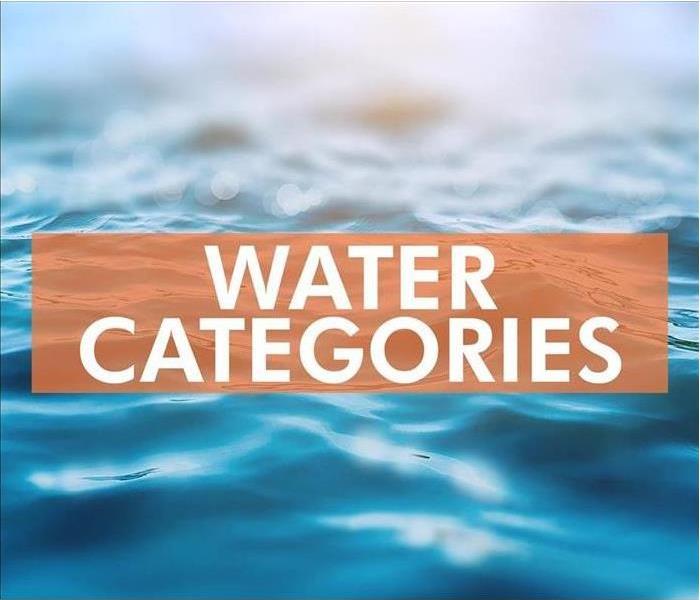 Three categories of water.
Three categories of water.
Common Causes of Flooding
For the uninitiated, all floods might seem equal; however, that is far from the truth. For example, a plumbing accident causes a clean water flood, while a sewer backup is a very toxic situation. That’s why the pros classify spillovers into three categories to show the level of pollution.
Common causes of flooding in Sleepy Hollow, IL include:
- Supply line bursts
- Heavy downpour
- Drain backup
Category 1: Clean Water
Clean water floods are typically a result of pipe breaks. They are easy to stop, as you only need to cut the water supply to the affected area. Even so, there’s the risk of electric shock and water damage, especially if it happens when nobody is at home. Generally, this flood is the least tainted on this list.
Category 2: Contaminated Water
A plumbing accident flood doesn’t stay clean for long. It eventually mixes with a lot of stuff, including household chemicals like soap, bleach, and drywall. While it might look unclean, contaminated water is nutritious to plants and should be poured in the garden or lawn. Consider it as the middle ground between a clean water flood and a sewer backup.
Category 3: Black Water
Blackwater is the most contaminated flood in the “book of spills.” It contains fecal matter that hosts all kinds of harmful bacteria and toxic chemicals known to man. This combo causes all sorts of nasty infections in people, and pets and damages the environment as well. For that reason, anything that comes into contact with blackwater requires urgent professional attention.
It is also worth noting that carpets and rugs cannot be salvaged after black water exposure. They should be discarded immediately after removal.
Removing contaminated water from a flooded house can be a daunting task for the average DIYer. It’s easy to miss a few critical steps in a cleanup, and that’s why you need a second opinion from a restoration professional.
What To Do After Fire Sprinklers Go Off
6/18/2022 (Permalink)
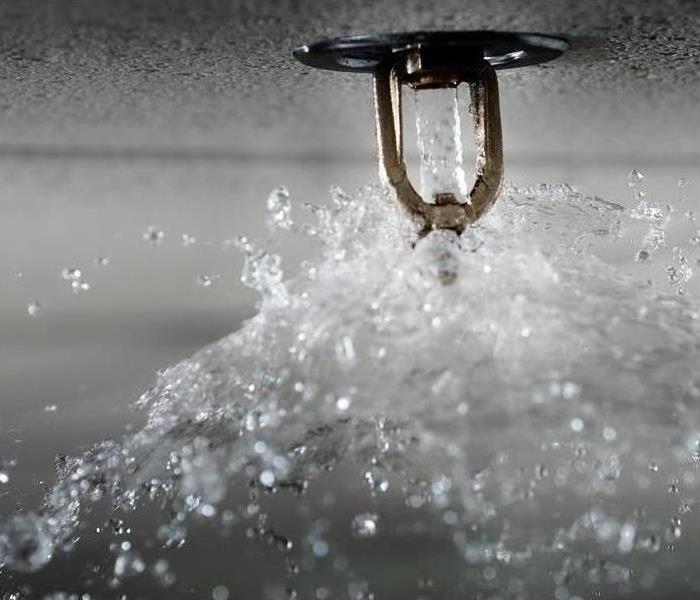 Fire sprinklers can go out in your building and cause flood damage.
Fire sprinklers can go out in your building and cause flood damage.
What Happens If Your Sprinklers Go Off by Accident?
In the event of a fire in your commercial building, sprinklers could prevent a small blaze from becoming a true disaster. However, what happens if your sprinklers go off by accident?
Water from sprinklers can damage sensitive equipment and create flooding problems if not dealt with promptly. Here are several easy steps to follow if fire sprinklers go off in your building.
1. Turn Off the Water
Usually, you will not be able to turn the water off yourself. Sprinklers will not turn off until a professional from the fire department arrives and turns off the valve. If sprinklers go off, contact the fire department immediately, even if you suspect that there is no fire.
2. Call a Restoration Company to Assess Water Damage
A professional water restoration company in Gilberts, IL, will be able to assess the flooding damage and provide prompt cleanup services. It is important to address all damage as soon as possible in order to prevent the growth of mold. A company with expertise in commercial damage will also help you determine what equipment can be saved and how to restore it to working condition.
3. Call Your Insurance Company
It is important to have your commercial property insurance information readily available so that you can contact the insurance company as soon as possible. A successful claims process requires prompt and thorough communication. Keep records of everything related to the event and any services that you receive from a restoration company.
4. Take Steps to Mitigate Damage
There are several things you can do as you wait for restoration professionals to arrive. For example, you can set up fans and dehumidifiers to help with the drying process.
A false alarm can be a nerve-wracking experience. Following these steps will help you protect your building and prevent flooding.
How Fire Sprinklers Engage as a Fire Starts
5/11/2022 (Permalink)
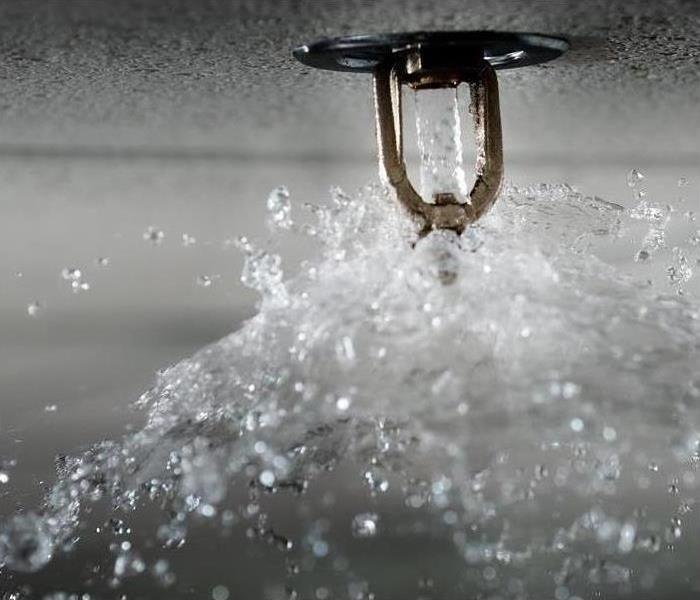 A fire sprinkler system could be a worthwhile investment for your company.
A fire sprinkler system could be a worthwhile investment for your company.
When a Fire Starts, How Do Fire Sprinklers React?
If your company is serious about fire prevention, a fire sprinkler system could be a worthwhile investment. The idea behind sprinklers in your building is simple enough: just as a fire starts, the sprinkler heads engage and dowse the flames before they can cause any damage. Of course, the technology behind the sprinklers is sophisticated and ever-evolving. How they work depends upon several key components.
The Pipes
Just as with the plumbing that spreads through the walls of your company in Barrington Hills, IL, your company's sprinkler system depends upon a network of pipes that carry water under pressure. The contractor who installs the system will locate the piping in the most strategic places or where a fire is apt to occur. This water is always in the pipes, ready to be called into the service of fire suppression if necessary.
The Head of the Fire Sprinkler
In regular intervals of several feet apart, the pipes have a head that contains a few hardware components that allow for the release of water. These sprinklers activate when the air temperature is hot enough, spraying water over the flames. The beauty of this system is that it operates quickly, at all times of night or day, and can put out a flame more quickly than a fire department.
This water release does require a fire sprinkler cleanup to take care of any water damage. A local fire mitigation team in Barrington Hills, IL, can come out and take care of the situation and prevent any further damage.
The Sensors
Finely calibrated sensors detect the flames. They must do this quickly, but they also are built so they will not trigger prematurely, which could result in unnecessary water damage to a facility. Another safety feature is that only the sprinkler heads closest to the fire activate.
A fire sprinkler system uses advanced technology to protect your company. It is constantly on the alert for dangerous flames.
Commercial Insurance and Mold Damage
4/12/2022 (Permalink)
 Mold in a commercial building in Carpentersville, IL.
Mold in a commercial building in Carpentersville, IL.
Mold Damage and Commercial Insurance
A mold outbreak in your commercial building is often a financial challenge for several reasons. You could experience damage to your property. Your business operations could be disrupted in the short term. Finally, there will probably be expenses related to a cleanup and restoration. Your commercial insurance could reduce some of these costs, but it is important to check with your insurance agent to see what your policy covers. A fungus exclusion protects insurance companies from large payouts due to fungal outbreaks. However, in certain circumstances, limited fungus coverage will provide some payouts for the repair and cleanup caused by mold damage.
More Financial Solutions
To protect the integrity of your property in Carpentersville, IL, you can also concentrate on prevention. Much of this centers around keeping your facility free of excess moisture. The following actions go a long way toward keeping fungi under control:
- Conduct regular building inspections
- Concentrate on maintaining proper ventilation
- Fix all water leaks ASAP
- Remove mold quickly if discovered
- Call for professional help
While commercial insurance could pay for some items, it is best to avoid a mold outbreak altogether. In many instances, this is as simple as understanding how mold spreads and taking a few precautionary measures.
Additional Strategies
In addition to mold insurance and preventative measures, it is important to contact an experienced mold mitigation team when necessary. A qualified company can arrive quickly and reduce expenses and additional damage. Technicians will perform an inspection and assessment of the property and go to work on removing mold. These workers will have the training and the equipment to handle fungal outbreaks both large and small. Best of all, they will clean up the area in a way that mold is unlikely to return anytime in the near future. If you wait too long to call in the experts, you face the possibility of more extensive damage. Commercial insurance is one of three pillars of beating mold.
How To Maintain a Commercial Roof
2/1/2022 (Permalink)
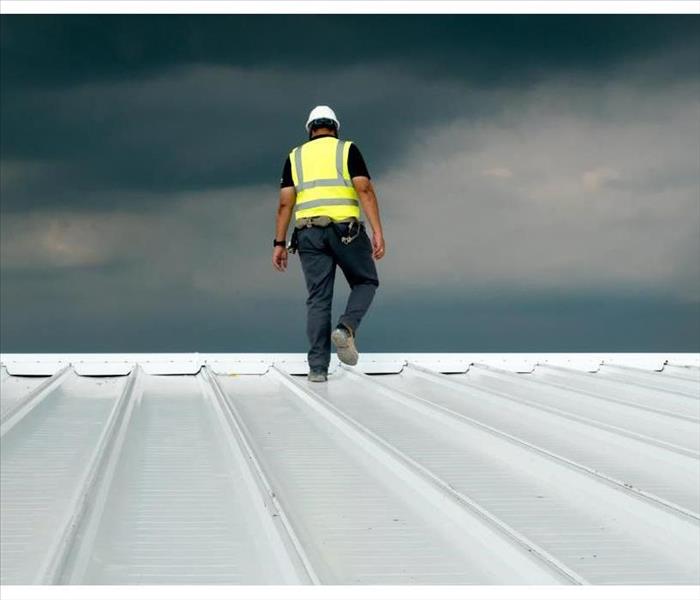 Property owners should schedule a professional roof inspection at least once a year.
Property owners should schedule a professional roof inspection at least once a year.
How to Keep a Commercial Roof in Good Shape
Commercial roofing can last for decades with regular maintenance. In addition to the following preventative measures, building owners or managers should also fix any roof damage caused by wind or storms as soon as possible.
Clear Drainage
One of the easiest ways to keep a roof in good condition is to regularly clean out the drainage system. Pooling water can undermine roofing materials, lead to leaks and shorten the lifespan of a roof. Be sure to clear out every part of the system. This may include:
- Downspouts
- Drains
- Gutters
- Scuppers
Clean the entire system at least twice a year. Roof drains may need to be cleared every three months during the spring and summer and every month during fall and winter.
Regular Inspections
Property owners should schedule a professional roof inspection at least once a year. Owners or managers can also check the rooftop on a regular basis, particularly after major storms. Look for any signs of common roof problems such as:
- Blistering
- Buckling
- Deformation
- Granular loss
- Missing shingles
- Ponding
- Punctures
Any of these issues may result in a leak. Fixing roof damage is an important part of overall maintenance.
Trim Trees
Minor wind damage may loosen roofing materials, but overhanging tree limbs pose a major risk. Owners or managers of buildings surrounded by tall trees should schedule regular trimmings. A fallen limb can cause extensive roof and structural damage.
Proper Coating
Roofing specialists can apply a waterproof coating to almost any type of rooftop. Elastomeric coatings protect the surface from environmental damage. A single treatment can last 10 to 20 years, depending on weather conditions and roof maintenance.
All of these methods can be useful for maintaining the rooftop of a commercial structure in Carpentersville, IL. Quickly fixing any roof damage that occurs may forestall the need for a roof rebuild. If a leak results in damage, contact a mitigation and restoration service.
Irrigation Systems: 4 Ways To Save Money While You Water
12/30/2021 (Permalink)
 Perform regular maintenance on your irrigation system.
Perform regular maintenance on your irrigation system.
Irrigation Management
While water issues like water damage are large financial concerns for commercial property owners, another expense comes from the mismanagement of irrigation systems. Most businesses are throwing thousands away every year because they don’t understand the four steps to proper irrigation management.
1. Meter Separately
Interestingly, many business owners throw away money every year paying sewer fees on water that never touches the sewers. Irrigation systems should be metered separately to avoid these added costs. You can call your local water department to install a separate meter at the irrigation main.
2. Schedule Properly
Another common oversight in sprinkler system management is the use of automatic functions. True, putting your system on a timer will allow you to ensure your lawn and landscaping are adequately watered, but when it is raining, your system does not need to be running. While small compared to other water issues, overwatering is terrible for your plants and your pocketbook.
3. Use Drought-Tolerant Plants
Also, when designing your landscaping choose drought-tolerant plants and shrubs. If you already have landscaping, then consider replacing some of your existing plants with ones that require less watering. Depending on how committed you are to using less water, you may even look into drought-tolerant grass for your property’s lawn.
4. Perform Regular Maintenance
The number one way to save money, however, is to perform regular maintenance on your irrigation system. It is common for sprinkler heads to break, leak and fail, meaning that you may be losing water daily even when you think your system is off. Schedule routine inspections with a plumbing specialist in the East Dundee, IL, area and talk with him or her about water upgrade suggestions that may help reduce your bills.
While water issues are an expense for every business, you may be losing a lot of money through irrigation system mismanagement. Make sure that you are metering separately, scheduling correctly, and performing regular maintenance to save yourself as much money as possible.
6 Steps To Properly Flush Your Water Heater
8/13/2021 (Permalink)
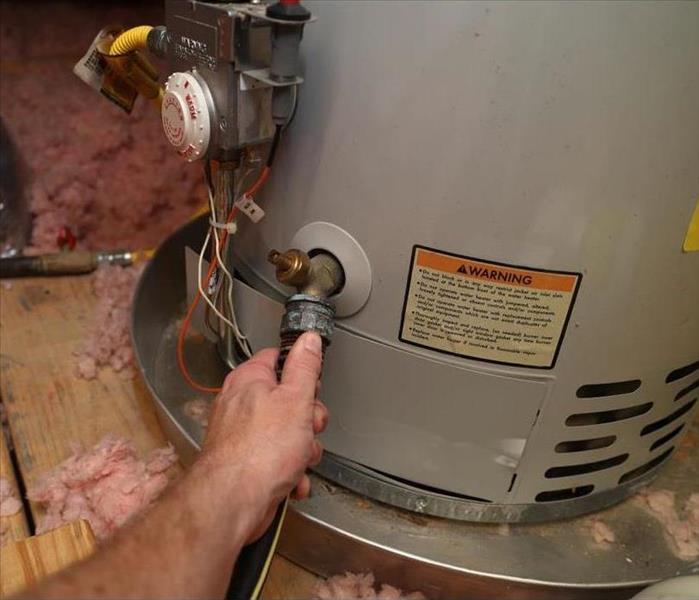 If you ever have a leak or water damage from your water heater, call SERVPRO
If you ever have a leak or water damage from your water heater, call SERVPRO
How to Flush a Water Heater Properly in 6 Easy Steps
To get the most use out of your water heater in Carpentersville, IL, maintenance is typically required. Over time, the appliance may collect mineral deposits that can cause permanent damage leading to leaks. It’s often important to perform a water heater flush every one to three years to clean out any damage-causing crud. Here are the steps to properly complete your water heater flush.
1. Turn off the Appliance
You should put safety as step number one on any maintenance project. Make sure the appliance is turned off and the gas valve closed. Before draining, you may want to wait until the water cools down so you aren’t risking a burn. If time is a factor and you decide not to wait, make sure to exercise caution as the water may be extremely hot.
2. Turn off the Water Supply
The cold-water supply valve connected to the top of the water heater should be closed to properly drain the unit. The valve typically looks like a regular garden hose valve and should be easy to turn.
3. Drain the Tank
Connect a hose to the spigot on the bottom of the tank. Position the hose to run into your designated drain area, such as a floor drain, and open the valve. Let the tank drain until it’s completely empty. Turning on the hot water at the kitchen sink can create airflow and allow the appliance to drain faster.
4. Flush out the Mineral Deposits
While the hose is still connected, turn on the cold-water supply valve to run water through the tank to flush out any loose mineral deposits. Once the water starts to come out clear, close the supply valve and the drain valve. Disconnect the hose.
5. Refill and Power up the Appliance
Open the cold-water supply valve to let the tank fill up. Once you’re sure the tank is filled, turn the gas back on and follow the proper instructions on lighting the element.
6. Repeat as Necessary on a Regular Basis
Never neglect your household appliances. Taking care of this appliance should prevent costly repairs and ensure its longevity.
With these six steps, you can be prepared to tackle the job. If you ever have a leak or water damage from your water heater, call on the professionals for cleanup.
How To Safely Eliminate Mold
7/24/2021 (Permalink)
 Mold cleanup services in Carpentersville, IL.
Mold cleanup services in Carpentersville, IL.
How to Get Rid of Mold Without Hurting Yourself
Mold can cause a major headache for your business. However, it is possible to combat this problem directly. Prior to conducting any cleanup, it is vital to find the right equipment to protect yourself and the rest of your business from further contamination.
• Masks
Protective respirators are essential gear, as spores can linger in the air during the removal process. Look for a protective mask with a high filter efficiency. The higher the number, the higher the protection level. For example, a mask with a label of 80 will prevent 80 percent of spore inhalation. Experts recommend a N-95 or P-100 mask.
• Googles
During cleanup, you will likely use a number of cleaning supplies. Guarding your eyes against these chemicals is important. Purchasing safety googles prevents tiny spores and chemicals from injuring your eyesight.
• Gloves
In the same way that you shield your eyes, covering your hands and arms is a necessary precaution during removal. Protect your hands with correctly fitting rubber gloves throughout the entire process. Make sure to properly dispose of each pair to prevent contamination of clean surfaces.
• Shoe Covers or Protective Suits
Shoe covers can prevent spore transfer throughout the whole building. Remember to remove and replace shoe covers every time you go in and out of a mold-infested room. If you really want to avoid contact with any and every hazardous material, consider purchasing a full-body protective suit. Both of these items can be purchased online and in stores. However, in case of a serious mold infestation, it may be best to contact mold disposal experts so that they can conduct a large-scale cleanup safely.
Any mold cleanup can be daunting to a business owner in Carpentersville, IL. Regardless if it is small mold growth or a large-scale outbreak, wearing the proper protective tools is a vital step in fighting off this troublesome fungus. With the help of all this equipment, you can protect your business’s future as well as yourself and your employees.
What Do You Need To Look for During a Pre-Storm Inspection?
6/24/2021 (Permalink)
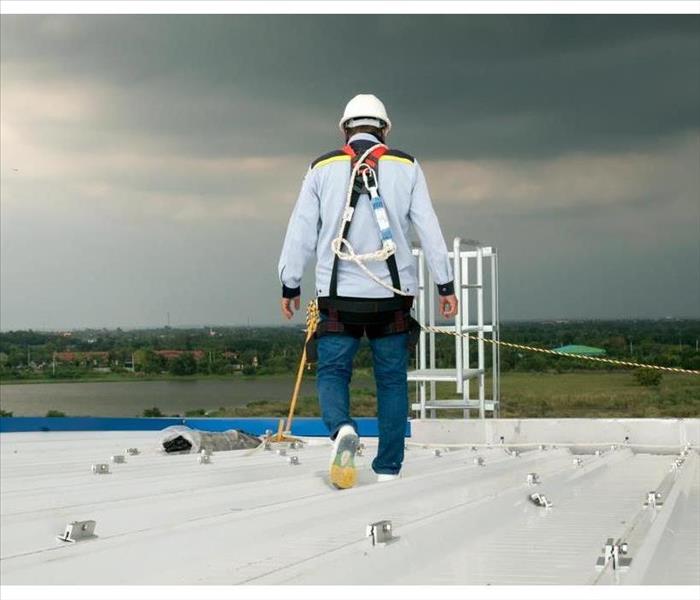 Roof inspection in a commercial facility.
Roof inspection in a commercial facility.
Pre-Storm Inspection
Did you know that your commercial property in East Dundee, IL, may benefit from a pre-storm inspection? Knowing the state of your building can help you better understand the damages a storm causes. This type of assessment is an important part of exterior maintenance. What should you look for as you and your storm remediation expert walk around your property?
Roof Damage
The first area you should look at before a storm passes through is your roof. This system can be quite vulnerable during a storm. Check for signs of existing damage, including the following:
- Loose roofing materials
- Rusted edging
- Blocked vents
Keeping your building maintained can make it more prepared to withstand the onslaught of a storm. Your roofing system, for example, needs to be in top shape to keep water from entering your space.
Siding Problems
Check the siding of your building as well. Here you want to look for signs of material corrosion or degradation. The signs you look for will depend on the type of siding your property has. A bricked façade, for example, may have loose sections or worn grout lines. Vinyl siding may be warped or cracked. As you and your professional walk around the property during your exterior maintenance, try to keep your eye out for anything that isn't as it should be.
Window Weakness
Another important focus of a building inspection is the windows. If the weather stripping around this structure is worn out, you may get water inside your space during even the lightest storms. Check these fixtures for leaky seals and loose panes to make sure your building is as watertight as possible.
Performing exterior maintenance prior to a storm can help you and your building better make it through any bad weather. If you neglect this type of inspection, you may miss early warning signs of weakness that could lead to damage because of high winds and rain.
Should You Provide Burn First Aid in Your Business?
4/30/2021 (Permalink)
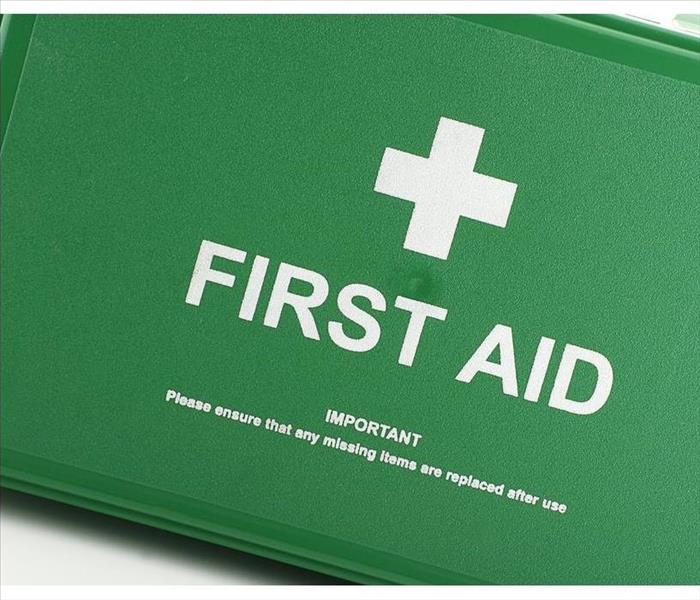 First aid kit
First aid kit
Owning a business in Gilberts, IL comes with a bunch of requirements. One that sometimes is overlooked is OSHA’s rule that all employers are “required to provide medical and first aid personnel and supplies commensurate with the hazards of the workplace.” This includes being ready to treat burns from fire damage.
What’s Required To Be Inside a First Aid Kit?
While each kit may need to be customized for your type of business, there are some basic items that are required everywhere. There are three critical types of aid that may be required:
- Wound care
- Eye care
- Burn care
There are 2 different general classes of pre-made aid kits. A class A kit is designed for common workplaces without unusual hazards, such as an office, warehouse or restaurant. A class B kit is for businesses with more dangerous activities, such as manufacturing, metalworking or welding.
As the risks increase, OSHA will require more items. Your local fire restoration experts can help you figure out which aid kit is right for you as well as prepare your business to avoid and survive disasters.
When Should You Treat Burn Injuries?
Fire damage is one of the leading causes of injuries and insurance claims in the U.S. Every business should be ready to deal with common burn injuries. However, you should only treat light burns. Serious burns require immediate medical attention, so call 911 without delay.
A heavy burn will have these characteristics:
- Leathery and dry skin.
- Skin may appear white, brown or black.
- The burn is larger than 3 square inches.
A light burn, however, will appear quite different:
- Superficial damage
- Red skin
- Small blisters
- Smaller than 3 square inches
How Should You Treat Light Burn Injuries?
Run the area under cold water or apply a sterile, wet bandage. Also apply soothing lotion, such as aloe vera or an antibiotic gel. You should then bandage it lightly.
A light burn injury can be dealt with pretty easily. Deep or widespread burns are a different story. If you know the difference, you’ll be prepared when fire damage strikes your company.
Common Questions About Mold
2/4/2021 (Permalink)
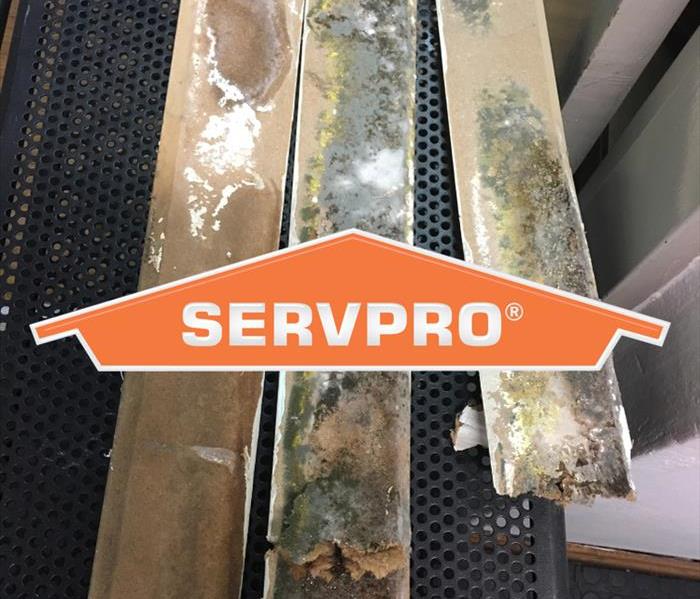 A strong, musty odor may indicate hidden mold behind drywall or under carpeting.
A strong, musty odor may indicate hidden mold behind drywall or under carpeting.
In many cases, people will see mold before they smell it. However, sometimes, the mycotoxin that mold releases as it grows are a good indication that there is mold in your building in Gilberts, IL. Either way, you need to know how to identify it and get rid of mold smells.
What Can Indicate Mold?
Never ignore the musty odor in your business.
Anytime you smell mycotoxin or experience a mold issue, you should call a remediation company and have the excess spores removed quickly. This will prevent further damage to your building.
Does Mold Smell?
Mold has a noticeable odor. Most people consider it musty or earthy. Others say it resembles sweaty socks. If you've ever opened a food container with some fuzz growing on it, you have experienced this smell. Depending on how long the mold has been growing, the mycotoxin released during its growth can range from mild to extremely disgusting.
How Do I Banish Mold Odors?
Mold odors are just one problem associated with mold. Sometimes, getting rid of them can be as simple as scrubbing the walls or throwing away items that have gotten wet. Other times, you will be required to hire professionals to help reduce your business's number of spores. While you wait for the team to arrive, you may want to open some windows and push the scent out with some fans.
A smell can be a good indicator that there is mold in your building. This scent often resembled dampness and dirt. Remember that you don't want to have mold in your business. A musty smell is a good reason to hire a mold remediation team. They can remove excess spores. This will remove the scent and help you keep your business running.
FAQs About Commercial Property Insurance
1/11/2021 (Permalink)
 Commercial insurance is something you should consider for your property
Commercial insurance is something you should consider for your property
FAQs About Commercial Property Insurance
When you open a business, commercial insurance for your property is one of the many things you should consider. It covers the cost of hiring remediation professionals after a disaster and can replace your items after theft or vandalism. This is especially important for small businesses that lack the funds to replace their items when faced with a disaster.
What Does It Cover?
Commercial insurance covers any damage or loss to your property, including buildings, equipment, furniture, inventory, office supplies, and utilities. It will also cover these items if you do not own them, but they are located at your business.
How Do You Buy It?
You can purchase property insurance in a commercial insurance bundle or as an individual policy. Based on your shop's items, you will want to select the right insurance policy for you. There are two types of policies, including:
- Replacement cost policies
- Actual cash value policies
What if You Are Renting the Building?
A lot of small business owners rent or lease buildings. If you decide leasing is the best option for you, check your agreement. In some cases, you will be required to have a certain amount of insurance for the property. Then, make sure you shop for a policy that will offer this amount of coverage.
What Goes Into the Cost?
Several factors go into the cost of property insurance for your business in East Dundee, IL. This includes the value of your property, your business's exact location, and the policy you select.
A commercial property insurance policy will cover the costs to repair or replace your building and any items you lose in the event of fire damage, theft, or other disasters. It will also cover any items you are responsible for, even if you don't own them. You should select a policy based on the items that are in your shop. The policy you select, your property's value, and your location will impact the amount you pay.
Troubleshooting Trouble in Your Irrigation System
12/17/2020 (Permalink)
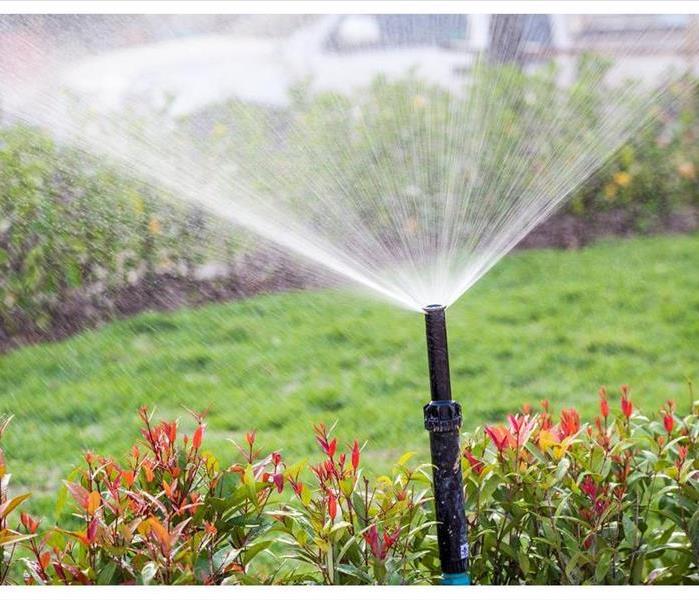 Your investment in a sprinkler system speaks to your business' public image
Your investment in a sprinkler system speaks to your business' public image
Tips To Help You Keep Your Sprinkler System In Good Working Order
For business owners in West Dundee, IL, a commercial irrigation system provides reliable, efficient watering to ensure well-hydrated lawns, trees, and greenery. However, from time to time, sprinkler systems malfunction causing irrigation problems that can wreck havoc on your exterior grounds as well as your property's interior. The most serious threat comes from standing groundwater, which can saturate a building's foundation or basement and cause flooding.
Broken Supply Lines
When your irrigation system is not operating properly, look for:
- A broken timer, solenoid, valve, or wire failure
- Seeping water, often the result of a split joint or cracked pipe
- Gushing water from a broken sprinkler head
- A timer breakdown caused by corroded wires or faulty connections
Cracked Supply Lines
Tree growth and high traffic are the most common reasons for irrigation failure. Trees, with thick, expansive root systems, can corrupt supply lines by breaking into the plastic piping and filling them with growing roots. If you notice a decrease in water pressure, it can signal a cracked pipe within your system.
Underground plumbing lines are sensitive to repeated high traffic. The weight of people, bicycles, kick scooters and strollers can all harm supply lines by compressing the soil and cracking the piping underneath. Keep in mind that the greater the traffic, the more weight that's exerted and the heightened chance your watering system's joints or pipes eventually will be damaged.
Your investment in a sprinkler system speaks to your business' public image. Protect that investment. By troubleshooting trouble in your irrigation system, you can address small problems before they become big (and expensive) ones. Unfortunately, flooding from faulty irrigation can and does happen. If you're ever faced with water damage to your building, it's best to rely on professional cleaning and restoration services to quickly get you back to business “Like it never even happened.”
3 Tips for Winter Storm Preparation
11/6/2020 (Permalink)
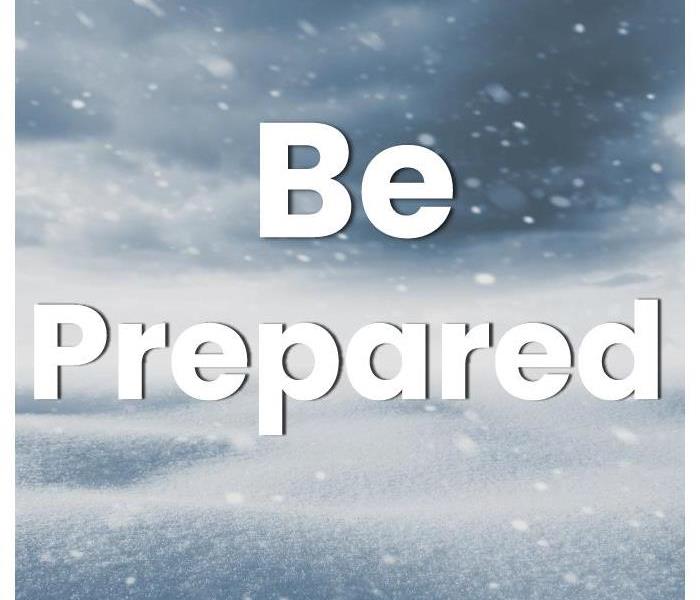 Prepare your building for those cold winter days
Prepare your building for those cold winter days
Protect Your Building From Those Cold Winter Days
A winter storm is a common-place occurrence when you are a business owner in Carpentersville, IL, but are you sure that you are doing everything you can to protect your building from storm damage? Being proactive, attentive, and prepared will help you get through those cold winter days.
1. Schedule Inspections
Start your winter season prep by making sure that your building is well-maintained and the essential systems that keep it going are operating at peak performance. Inspect the entire building for cracks in the walls and any other structural issues. Schedule routine inspections for your roof, HVAC, and water systems so you know of any potential issues that could be exacerbated by cold weather. Having experts look at your property will help you keep winter-related problems minimal.
2. Create a Checklist
It seems inevitable that you will have to deal with the aftermath of a winter storm at some point. Having a winter checklist makes it easy to stay on top of duties that keep your building running and employees safe. Here are some to-dos that should be routine:
- Snow removal from sidewalks, steps, and heavily trafficked areas
- Check pipes and water systems to make sure they are not frozen or exposed to extreme cold
- Search for ice buildup on roofs
By creating a routine, you can discover and resolve small issues before they become big problems.
3. Have a Backup Plan
Even the best-laid plans go awry. It is good to have a disaster restoration plan in place just in case you need to fix some damage. Include instructions on how to shut off your water supply, electricity, and any other systems that could be compromised. You should also provide emergency contacts and the number of a commercial restoration company.
Weathering a winter storm does not have to be so nerve-wracking when you know that you have prepared your business and can handle whatever winter throws at you.
How a Fire Restoration Specialist Can Help Your Business After a Fire
9/21/2020 (Permalink)
How Professionals Use The Fire Restoration Process
In the aftermath of a large fire, business owners might wonder if their business will ever recover from the smoke damage and when they can resume operations. Fortunately, if your business in Barrington Hills, IL, ever has to deal with this unfortunate circumstance, a fire restoration specialist can help restore your building and many of the items inside. Here is some information on how these professionals use the fire damage restoration process.
1. Inspection
After making contact with a restoration company, a specialist will immediately be sent out to your building. They begin by fully inspecting the area for damage.
2. Board-Up and Roof-Tarp
Once a plan has been made, the specialist starts by placing a tarp on your building’s roof and boarding up any walls or windows affected by fire or smoke damage. This helps keep the area safe to work in.
3. Water Removal
Next, the specialist will remove any water from the area to avoid the immediate damage flooding water can cause. Often, this water comes from hoses used to extinguish the flames or a burst pipe.
4. Smoke Cleaning
An important step in the fire restoration process is to remove smoke and soot from all surfaces of the building. This will also help prevent any further smoke or soot damage from spreading.
5. Sanitizing
Once smoke and soot have been removed from your building and belongings, everything will be cleaned and sanitized. This includes fully cleaning furniture and objects and odor removal.
6. Restoration
Finally, the specialist will work to get your building back to its original position. This step in the process may include rebuilding of drywall, installing new flooring, and other repairs.
While the priority in a fire is always to get everyone to safety, fire and smoke damage can be very damaging to the structure of the building and result in the loss of important documents, equipment, and more. Fortunately, there are many ways restoration specialists can help get you back on your feet.
Build Your First Aid Kit According to OSHA Standards
8/15/2020 (Permalink)
When creating a first aid kit for your business, you should always keep in mind that you’re required to adhere to specific standards to keep your emergency supplies up to code. To ensure your kit adheres to OSHA’s current requirements, you’ll need to take several issues into consideration:
- The contents of your emergency kit
- The number of employees you have in a space
- The number of different business functions occurring in a single building
Taking these details into consideration allows you to identify which products and how many kits you need in total to keep your workplace safe on a day-to-day basis.
First Aid Kits
What Goes in a Kit?
To have a complete first aid kit for your West Dundee, IL, business, you’ll need to include:
- A number of gauze pads measuring at least 4x4”
- 2 larger gauze pads measuring 8x10”
- A box of adhesive bandages
- A package of 2”-wide gauze rollers bandages
- 2 triangular bandages
- Sealed moist towelettes or another wound-cleaning agent
- Scissors
- A minimum of 1 blanket
- Tweezers
- Adhesive tape
- Latex gloves (and a recommended latex alternative in case of allergies)
- Resuscitation equipment like a pocket mask
- A pair of elastic wraps
- A splint
- Directions for contacting emergency services in your area
How Many Kits Do You Need?
Each kit is designed to cover two to three people, meaning you’ll need to have more kits the more employees you have on the job at a time. Furthermore, you’ll need at least one kit for each individual operation taking place at your particular place of business, or at least increase the quantities of the supplies in each kit to reflect the number of employees and operations on hand.
Assembling a proper first aid kit should be one of your top priorities when it comes to taking care of your employees’ needs on the job. Consult OSHA’s official guide on the matter for a great place to start when putting together your emergency kits.
3 Ways To Mitigate Water Damage
6/23/2020 (Permalink)
Water Damaged Restoration Professionals Recommended
For a business in Sleepy Hollow,IL, the possibility of having to conduct a pipe burst cleanup, can seem daunting. Fortunately, there are a number of ways to mitigate potential water damage before the problem even occurs. Here are a few many water damaged restoration professionals recommend.
1.Regularly Inspect the Plumbing
One way to protect your business property against water damage is too regularly inspect for any potential problems. This may include looking for potential supply line leaking, pooling under windows, puddling in basement areas, proper drainage, checking pipe joints, and other potential problems. It's recommended to schedule a professional to go through this process regularly.
2. Have a Professional Conduct Repairs
In the event the property does experience water damage and a pipe burst cleanup is necessary, it may be best to contact a professional to conduct any repairs. A water damage restoration service such as SERVPRO has the tools and equipment, as well as knowledge, to check for related damage and restore the property back to working order. They may also be able to help ensure that no mold growth is found, and advise as to any mitigation steps you may want to take.
3. Start Mitigation Early
Preventing a water cleanup can start before you even think the property may have problems. Some easy steps include ensuring that there are proper gutter and drain spouts to catch storm water runoff from the roof and direct it away from the building, checking that landscaping is sloped away from the building to avoid pooling water around the foundation, and that any gutters and drainage ditches are kept clear of debris to prevent overflow.
There are some easy mitigation steps you can take before water damage even become the problem. Remember to regularly inspect your plumbing, and if you to experience problems talk to a professional about any pipe burst cleanup needs you may have.
Recovering Items From Soot
4/21/2020 (Permalink)
 Cleaning up soot residue must be done as quickly as possible
Cleaning up soot residue must be done as quickly as possible
Handling fire loss at your Barrington Hills, IL, property can be challenging. One of the sneakiest obstacles you'll encounter after a fire is soot damage. Here's how to find it and what to do about it.
Where Can Soot Hide?
Soot occurs when organic materials such as metal, plastic, paper, and furniture partially burn. It can hide in a wide variety of places, including the following:
- Inside the wires and access buttons of electronics and personal devices
- On clothing and in fabrics, including upholstery and drapery
- On flat surfaces, such as desktops, countertops, walls, and even the ceiling
Soot is so fine that it can cling to cloth for days, even after it's run through a washing machine. Soot proteins can cling so tight to walls and similar surfaces that you might have to go over the area three or more times before dislodging the soot. In general, soot particles can circulate in the air for months after a fire loss. For these reasons, it's usually safer and more efficient to enlist the help of a professional fire damage mitigation company.
What Valuables Can You Repair or Clean?
A trained fire restoration company may be able to recover a variety of items after soot or smoke damage:
- Copy machines
- Postage meters
- Carpet areas
- Floor tiles
- Furniture
- Windows
- Lighting fixtures
- Vacuum cleaners
Technicians can walk you through the restoration process from start to finish using sensors, tools, and techniques to ensure your safety.
What Valuables Should You Replace?
While some staples of your office can be repaired, others most likely cannot. If soot lingers on the following everyday items, be prepared to replace them:
- Disposable cleaning wipes for hard surfaces, microfiber cloths
- HEPA filters
- Bare metal surfaces
- Deodorizers
- Safety gloves, glasses, and masks
- Lighting fixtures
- Frayed chargers for laptops and devices
Know what to expect after a partial fire loss. Soot can be toxic and tricky to clean. Ultimately, your goals should be to mitigate business interruption, ensure the safety of your employees and recover your valuables as soon as possible.
Key Differences Between Mitigation and Restoration
3/13/2020 (Permalink)
 Flooded commercial building in East Dundee, IL
Flooded commercial building in East Dundee, IL
Anyone who has ever struggled with a disaster in the workplace, such as a flood, understands what a trying time it can be. The immediate emergency requires quick action and response, and your primary concern should be everyone's safety. Rebuilding your office can take time, so it's important that you hire the right flood cleanup company.
Evaluation
Once you've identified the source of the flooding, make sure you stop it and get everyone out of the building safely. A reputable restoration company should arrive on the scene within a few hours of your call. The team will start with the following processes:
- Determining how the flooding began and ensuring that the water is no longer entering the building.
- Examining the extent and severity of the damage.
- Formulating a cleanup plan and sharing it with you.
Mitigation
A professional flood remediation team will first focus on addressing the damage the water caused. Mitigation involves removing all the water from the area and thoroughly drying the floor, walls, ceiling, and furniture. Crews will then use potent chemicals to kills any bacteria and discourage the growth of mold. Technicians can use specialized techniques to clean and dry documents, electronics and other materials in the workplace. The mitigation process can be fast.
Restoration
Before you can return to your office in East Dundee, IL, the building needs to be in sound condition. Once the cleanup process is over, crews will start to rebuild and store damaged areas such as drywall, carpet and other flooring materials, the roof and other areas of the office. Restoring your building can take weeks or even months, depending on how bad the damage was. During the restoration phase, the flood cleanup company will board up windows and tarp the roof to keep out the elements and to secure the building.
An experienced flood cleanup company has the skills and tactics to help you return to the workplace. You can feel good about the efficient work these teams will do.
Mitigation Versus Restoration at Your Business: What Are the Differences?
12/23/2019 (Permalink)
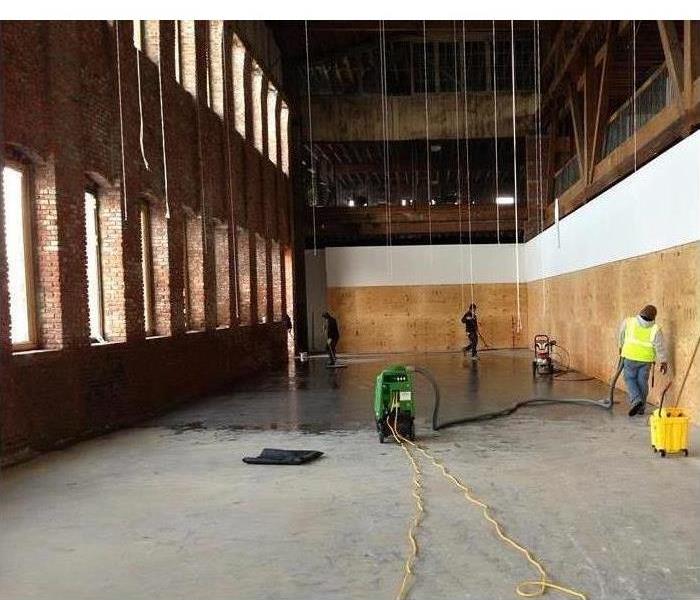 Restoration in Carpentersville, IL warehouse
Restoration in Carpentersville, IL warehouse
When a major flood hits your Carpentersville, IL, business, the results can be catastrophic. You may find yourself facing soaked inventory, electronic equipment and other items that are vital to the day-to-day operations of your company. Calling in a flood cleanup company can help you recover; however, knowing what to expect and an understanding some common terms such as mitigation and restoration—as well as how they differ—may help you feel more confident about the future of your business.
Mitigation and First Steps
When you make an initial call to a restoration company, the technicians that arrive will likely make a rapid assessment of the flood damage and take action to prevent floodwaters from spreading through the following:
- Redirecting flooding runoff to an outdoor area
- Draining areas that contain vital electrical systems
- Checking the soundness of floors and ceilings on upper levels
These first steps, which are part of the mitigation process, are likely to take place quickly so the worst of the damage can be slowed or temporarily repaired until the restoration process can begin.
Forming a Restoration Plan
When you work with a flood cleanup company, the technicians will probably discuss a restoration plan with you once mitigation has been completed. Repairs and reconstruction of damaged building materials may take weeks or even months, and a timeline will likely be included in the plan. Other items in the long-term restoration process might include mold control and removal, the replacement of damaged electrical systems and the installation of new insulation, carpeting and other flooring.
A Prevention Plan for the Future
A mitigation and restoration service can also help you formulate a flood prevention plan to help protect the future of your business. This plan might include how to avoid indoor floods caused by broken plumbing pipes and toilets and how to safeguard your property from outdoor flooding. This could help you to protect your customers and employees and prevent future financial loss.
As a business owner, handling water damage can be stressful. However, learning about mitigation and restoration from a flood cleanup company might help protect your Carpentersville, IL, business.
4 Types of Water Problems You May Experience in Your Commercial Building
9/23/2019 (Permalink)
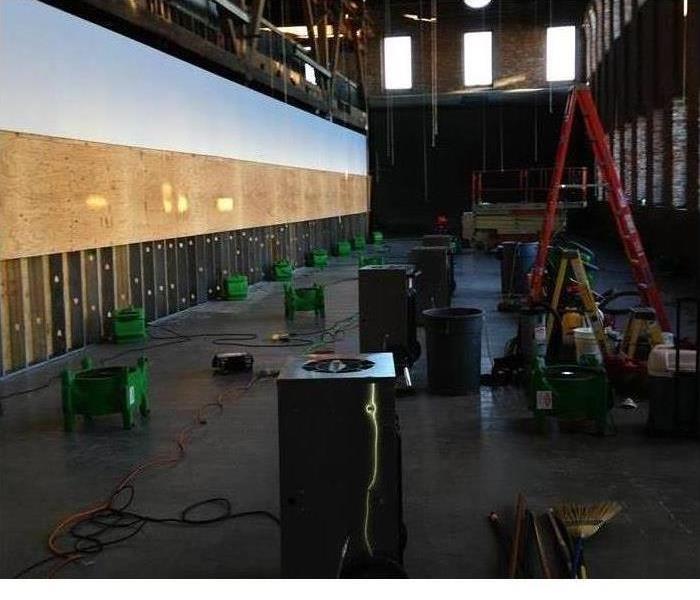 Commercial water loss in a West Dundee, IL warehouse
Commercial water loss in a West Dundee, IL warehouse
Causes of Water Damage in Your Building
If you own a building in West Dundee,IL, there is a chance that you will encounter water damage at some point. This is a common problem that affects commercial buildings of all types. There are several causes of water damage, from leaking pipes to heavy rain. The following may affect your building.
1. Leaks
While they may not seem like a big problem, leaks can be costly. If there are cracks in your roof or walls, a leak in these areas may contribute to the spread of mold or rotting materials within the structure of the building. Leaks in the plumbing system can result in wasted water and higher bills.
2. Damaged Pipes
Along with costing money and causing water damage, leaking pipes can also indicate damaged or aging pipes. Over time, your pipes can begin to corrode, resulting in leaks. If these are not repaired quickly, you can end up with a broken pipe and a flooded building.
3. Plumbing Problems
A toilet backup is not always cause for concern, but it can sometimes be the result of a larger problem. Flushing products that were not designed for it, such as paper towels, down a toilet can cause clogs that need to be removed. A pipe break or overgrown tree root can cause plumbing issues as well.
4. Storms
While you can prevent damage from many sources by performing proper maintenance, this is not always the case with severe weather. You may be able to reduce some of the damage by keeping your building in top shape, but storms can be unpredictable. Particularly if there is a flood, you may end up needing a large amount of cleanup and repairs.
Whether it is from leaking pipes or another source, you should make sure to have water damage cleaned up quickly. This will help prevent secondary damage, like mold growth and warping wood. An emergency restoration service can perform any necessary repairs.
How to Prevent the Spread of Mold
4/11/2019 (Permalink)
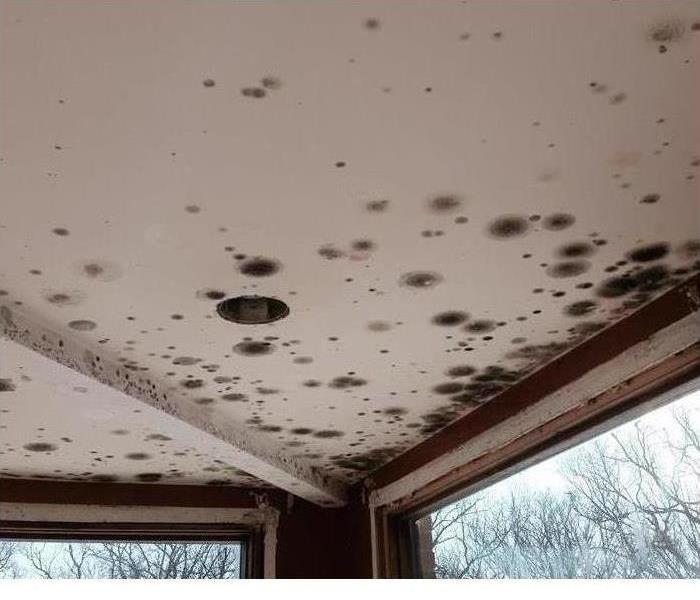 If you have mold damage in your West Dundee, IL home call SERVPRO
If you have mold damage in your West Dundee, IL home call SERVPRO
Preventing Mold Spread
Mold cleanup is a significant undertaking and one that is only complicated in commercial and rental properties. Beyond the threat of black mold, mold spores can spread throughout a property well beyond the initial contamination site. Therefore, to protect your property and tenants, it is essential to take the appropriate steps to reduce the risk of spread.
1. Close Doors and Windows
When you have a mold problem, ventilation can be your enemy. While ventilation is useful for preventing initial mold growth, it can actually contribute to the spread of mold when a problem already exists. Therefore, to limit exposure, you should close doors and windows in an attempt to quarantine the problem to one area.
2. Turn HVAC System Off
While not always possible in commercial properties, you should turn off the HVAC system to the building. Leaving an HVAC unit on can increase the spread of the infestation by sucking and pushing mold spores through the ducts and throughout the property; this is especially important when dealing with black mold. If it is not possible to completely turn off the unit, then you may want to adjust the temperature settings to limit how often the unit turns on.
3. Turn Off Water
If the mold issue stems from a moisture problem caused by a leaky or broken pipe, then it is wise to turn off the water to that pipe. While it may not be possible to completely shut off the water supply to the building due to tenant rights, most rental properties will have individual shut-offs for each unit, allowing you to turn off the supply to the contaminated unit.
4. Call In a Specialist
Any fungal problem should be dealt with by a mold remediation specialist in the West Dundee, IL, area. These individuals are trained and certified in safe removal practices, meaning that you and your tenants are protected.
Any mold problem, especially toxic black mold, should be handled with care. The main concern is limiting exposure by preventing the spread of mold spores. Therefore, follow the steps above and contact a specialist.
3 Critical Steps in Fire Sprinkler Maintenance
1/10/2019 (Permalink)
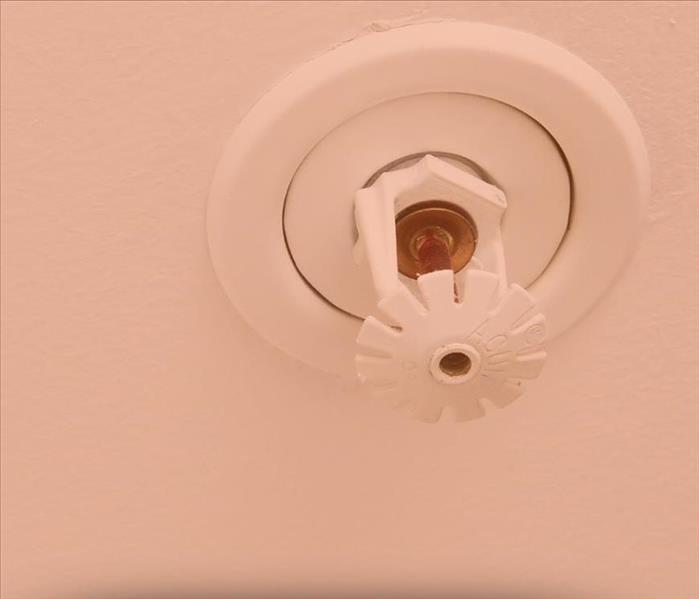 Each month check the heads of your fire sprinkler system in Carpentersville, IL
Each month check the heads of your fire sprinkler system in Carpentersville, IL
In many cities across the country, fire sprinkler systems are mandatory to minimize damage and threat posed by commercial fires. And with good reason: Within minutes, these sensor-operated tools can pour hundreds of gallons of water onto a breaking fire. But these defense mechanisms are only as useful as they are operational. Is your fire suppression system ready for action? Learn three ways to ensure your Carpentersville,IL, system is ready to go if the worst happens.
A sprinkler system is mechanical in nature, which means it includes a variety of elements that need to be monitored often.
Some of The Main Areas for Maintenance Include:
- Valves
- Pump units
- Sprinkler heads
- Gauges
If trouble is going to arise, these are some of the main places it will happen.
Gauges
At least weekly, look at the gauges on your system. You’re looking for signs of pressure problems. Air and water reads should be normal and there should be no signs of physical damage. This is critical because pressure is a big part of what allows a fire sprinkler to work, should a blaze erupt.
Valves
Inspect valves frequently to ensure they haven’t been tampered with or closed. National fire organizations estimate that as many as two-thirds of fire mishaps can be linked to sprinkler valves locked in the closed position. Consider lockout devices if you find valves are accidentally getting closed.
Sprinkler Heads
Each month, these should be checked. You’re looking for signs that sprinkler heads don’t match plans, are chipped or otherwise damaged. More importantly, you want to make sure they’re not obstructed, creating a literal barrier to putting the fire out.
Fire sprinkler systems are responsible for saving commercial businesses thousands of dollars annually in fire damage, with only minimum fire sprinkler cleanup costs. Make sure yours are operational to ensure you can experience the benefit.
How To Handle Water Damage in a Commercial Building
12/31/2018 (Permalink)
Whether it’s a pipe burst, a plumbing issue, or storm flooding, water damage can cause serious issues for a business. If this happens to your commercial building, your main priority should be drying up the moisture as soon as possible. Here are five damage tips you can use to make the process easier.
1. Identify the Source
The first thing to focus on is to stop whatever is causing the flooding. If it is through an internal system, shut off the water. Once you have done this, try mopping up extra moisture and removing carpets and rugs. Don’t forget to wear protective gear while dealing with potentially contaminated water.
2. Open the Windows
Natural ventilation is one of the best damage tips for preserving the structure of the building. Heat or forced drying can warp wood and prevent contents from drying completely. Open windows if it isn’t humid outside and turn on fans for air circulation.
3. Remove Valuables From Affected Areas
When it comes to damaged technology, documents, and other precious items, water is a known culprit. Move valuables upstairs or away from flooded areas and freeze exposed documents to prevent further exposure and deterioration.
4. Get Professional Help
If you want to get the restoration process going as quickly as possible, call in remediation professionals. A restoration company can give you immediate advice, share cleaning tips, and suggest where to go next. They can also help dry the building, prevent mold from spreading, and restore the structure.
5. Take Pictures of Everything
If your business in West Dundee,IL, has insurance, it’s a smart idea to call them and get compensation for your losses. Try to document all affected areas so that the insurance adjuster can assist you in the best possible way.
These water damage tips can help you avoid the most aftermath following a flood. By keeping a cool head and acting quickly, you can get started on the restoration process.
Backup Generators 101
10/17/2018 (Permalink)
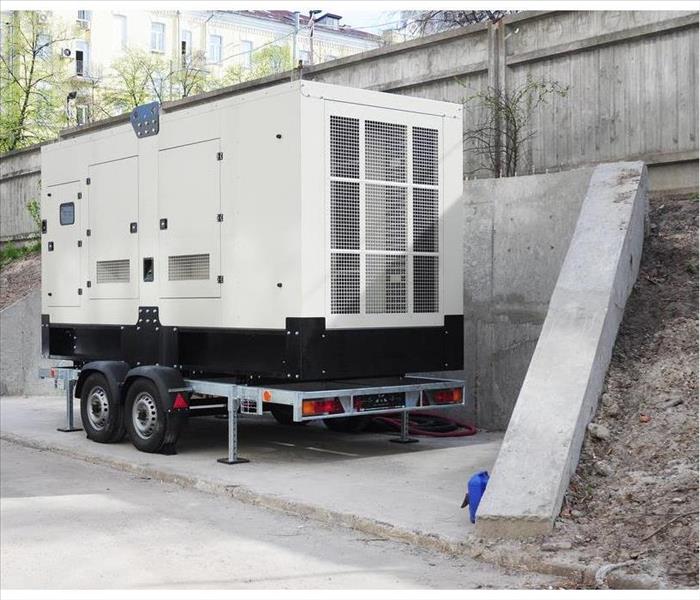 Commercial generator in Gilberts,IL
Commercial generator in Gilberts,IL
During and after a major storm, a commercial generator could provide the power you need to cleanup your property or to get your Gilberts,IL, business back into action. For the best results, you should understand how the machine works and how long you can count on its operation.
Types of Engines
There are several types of engines in this equipment, and the engine type affects how the machine functions, when and where it's used, and its efficiency. Some common options include:
- Marine
- Natural gas
- Petroleum
Inside the Machine
There are seven essential parts inside a commercial generator. These include
- Alternator
- Battery
- Cooling and exhaust
- Engine
- Fuel system
- lubrication
- Voltage regulator
In addition to these internal parts, there is usually a frame, rotating shaft, armatures, stator and commutator, and a brush assembly. Each component within the equipment plays an important role and may need maintenance or repairs for reliable operation.
How It Works
When you power the machine on, it doesn't create electricity; instead it stimulates electrical charges. Using mechanical interactions, electrical charges are sent through wiring and into the device requiring power. In other words, moving energy is converted into electricity. In many machines, copper coils and magnets provide the desired motion. This process is called electromagnetic induction.
When the power goes out, your backup power source may turn on automatically or you may need to connect it and get it running. Modern machines often have sensors that trigger the machine's operation. This option is valuable to many property owners. It's a good idea to put your machine to the test on an annual basis, so you can catch any malfunctions or damages before you need an extra source of power.
When Problems Arise
Sometimes, however, generator problems affect the equipment, putting you in a precarious situation if a storm is on the horizon. The synchronized operation of the internal parts is essential to appropriate operation. If you don't understand how the machine works, you may struggle to provide the proper maintenance and repairs to keep it running. Fortunately, commercial storm recovery professionals may know how to get your equipment back into working condition before the rain begins.
4 Recommendations To Lower Water Usage and Save Your Business Money
9/28/2018 (Permalink)
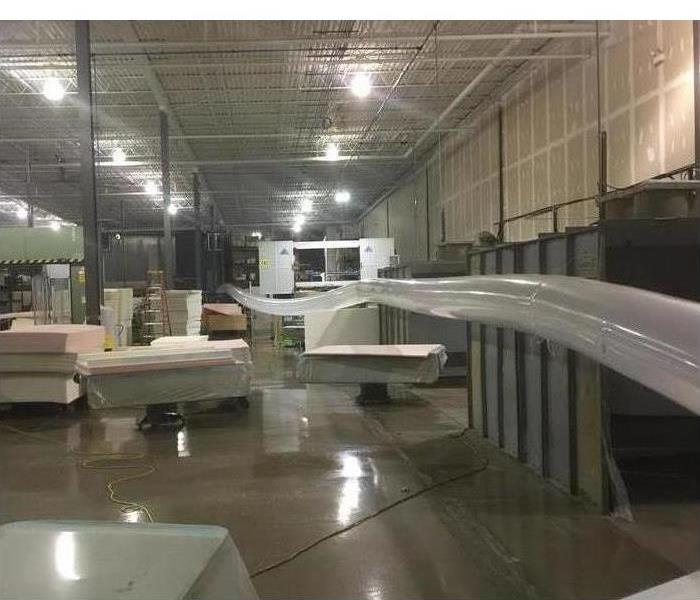 Commercial water loss in Gilberts, IL
Commercial water loss in Gilberts, IL
Water can be quite an expense for a Gilberts, IL, business. Not only is there an operation cost, but water issues from excessive wear can also lead to flooding that potentially closes off sections of your business. With these four recommendations, you can reduce your usage and slow down the deterioration of your utility system.
1. Seek Reasonable Alternatives to Water Cooling
Water is often used in businesses for cooling assets such as ice machines, compressors, condensers or vacuum pumps. These products have variants that utilize air cooling for similar performance without the water consumption. You should evaluate everything cooled in your business and determine if there are feasible alternatives.
2. Redesign for Efficient Landscaping
If your business has any green areas, you can take measures to save your green money. A helpful idea is to plant only vegetation that is native or can live with little watering. Additionally, by maintaining the soil’s health, your plants can retain any moisture and sustenance needed without waste.
If you live in a wet climate, recycling rainwater by collecting and storing it for future use can keep plants thriving. Without the risk of water issues from pipe wear, this natural liquid can be safer and more economical.
3. Compare Guidelines and Benchmarks in Your Industry
Trial and error can be costly. Fortunately, information is often available from other businesses in your industry. Expected usage benchmarks are publicly available, and studied sustainability reports provide information on the effectiveness of any water upgrade that others have tried and that you may be considering.
4. Inform Employees About Water Efficiency
Your employees are vital for reducing your business’s water misuse. With their help, you can have your employees be mindful and maybe inform you of ways to save. A reminder alone can be effective for keeping people vigilant of wasteful habits.
Even with smart practices, a professional water damage restoration crew may be necessary for the damage from water issues. Deterioration is inevitable from regular wear, but you can mitigate it beforehand. By cleaning up your business’s procedures, you can likely avoid having to deal with cleaning up a major flood later.
5 Simple Steps for Preventing Water Damage When Your Business Is Closed
6/18/2018 (Permalink)
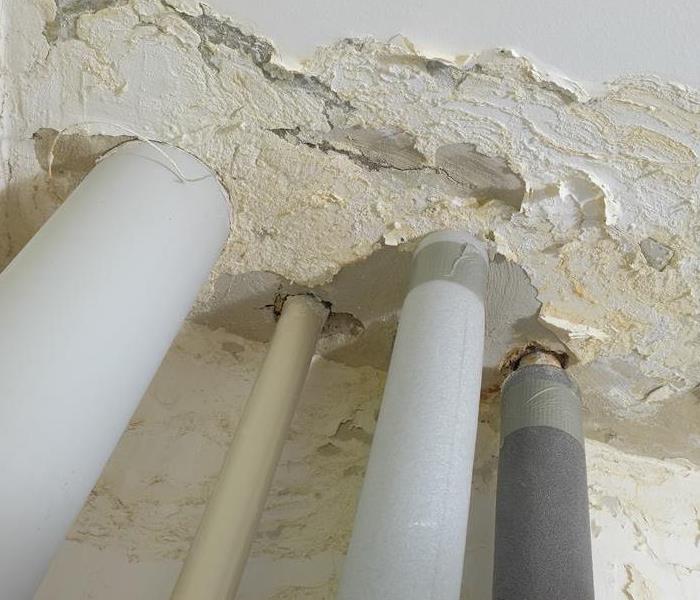 Simple Steps to prevent water damage when your business is closed for the weekend or season
Simple Steps to prevent water damage when your business is closed for the weekend or season
Whether you close your commercial property for the weekend or the season in Carpentersville, IL, you want to be confident that it will remain safe while you are away. The last thing you want to worry about is dealing with a flooded basement or water pipe repair when you return. Fortunately, there are things you can do to prevent a broken pipe from occurring in the first place.
How Do I Prevent Water Damage?
Before you close up shop for a period of time, you lock the doors and turn off the lights. But, do you remember to consider the water? Many people do not think about this until after a problem has occurred. Do not forget to take the following steps before you close your property:
1. Locate and shut off water supply to the main valve that supplies your business with water. Make sure you test it after it is shut off to confirm it is working correctly.
2. If there are outdoor faucets, run the remaining water out after you shut off the main valve.
3. When you turn the temperature down to save electricity in a cold climate, keep the thermostat at 60 degrees or above. This prevents water freezing in the pipes, creating the need for a water pipe repair upon your return.
4. Test the sump pump, as a heavy rain while you are gone increases the chance of a flooded basement if the pump is not working properly.
5. Check the gutters and down spouts, if you have them, outside your property to avoid a backup of rain water.
What Happens if I Return to a Broken Pipe?
If you return to your business in Carpentersville, IL, and water damage has occurred, do not panic. As soon as possible, contact a water restoration specialist. The company will immediately make a plan for the water pipe repair, drying of the space, cleaning and restoring your business to pre-damage condition. Your insurance company will likely cover the damage, so remember to call them as well.
For more on Carpentersville click here.
Assisted Living Water Loss
6/11/2018 (Permalink)
We often get calls for commercial water losses. Here at this loss, there was a pipe that burst on the top floor, causing 3 floors (30) rooms worth of damages. Fortunately, our team arrived so promptly and got to work immediately. Getting to work so quickly, we were able to prevent further damage. It took our crews approximately 6 hours to get all of the water extracted. Once extraction was completed, our crews had to remove the baseboards to ensure that the drywall would have proper drying. Then it was time to set the drying equipment. After a water loss, it is very important that equipment is set and monitored daily to ensure proper drying. After 4 days, we had everything dry and were able to begin with repairs.
Accidents Happen
6/11/2018 (Permalink)
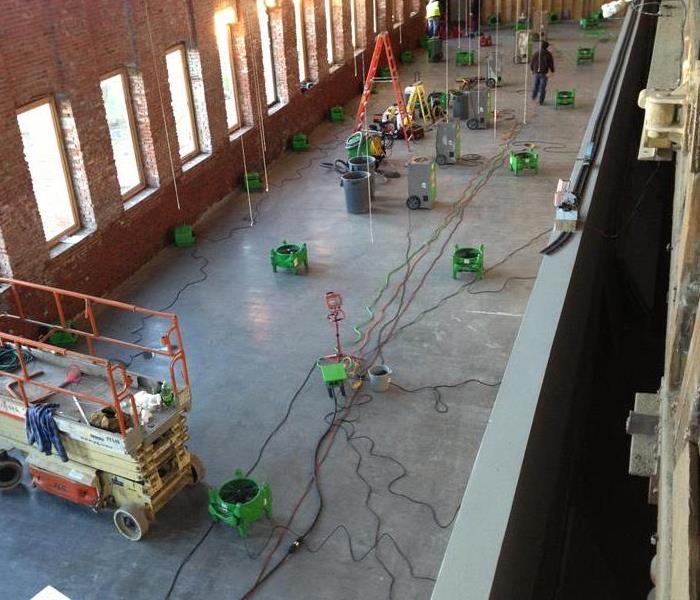 Large open room with drying equipment
Large open room with drying equipment
When an employee accidentally hits a pipe with a piece of equipment, it can cause a very large amount of water to spill out into your factory. That is exactly what happened here and unfortunately they couldn't locate the water shut off so the water ran for several hours.
Our crews were dispatched on a Saturday afternoon and worked in to the very early hours of Sunday morning. It took several days to squeegee and extract all of this water. It took a very large amount of equipment and several days to ensure the drying of this structure.
SERVPRO of East & West Dundee/ SW Barrington Hills are always on standby ready to assist in these large commercial water losses. Our technicians are highly trained water restoration. Call us today if you experience a water pipe burst.
Warehouse Commercial Loss
6/4/2018 (Permalink)
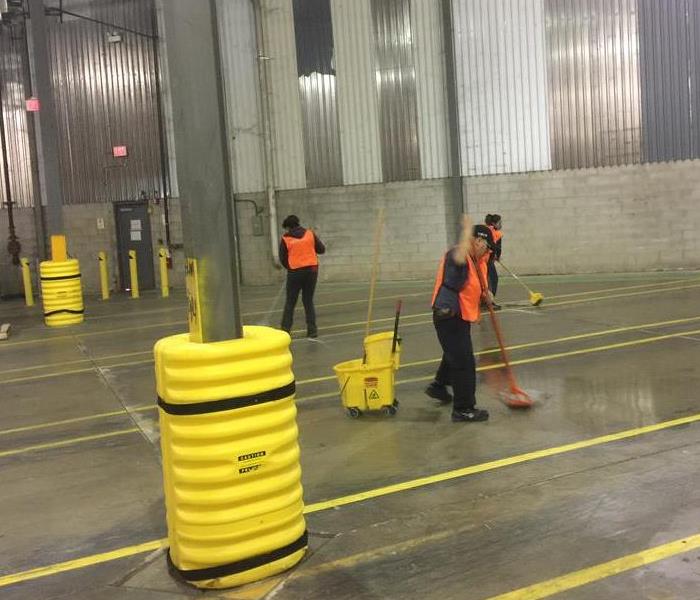 Cleaning Crew
Cleaning Crew
We here at SERVPRO of East & West Dundee/SW Barrington Hills are called in for commercial water losses all of the time. It is our goal is to get on site within 4 hours of your phone call. Arriving quickly means that we can put in our best efforts to prevent further damage. Our crews work around the clock to follow these steps:
1. Extract the water
2. Do any demo that may need to be done.
3. Set drying equipment
4. Monitor the moisture and air readings daily to ensure your business is drying properly
5. Remove the equipment
Once your structure is dry, our Production Manager will meet with your insurance adjuster on site to get a scope of services needed written. We want nothing more than to get you back to the way you were before the loss occurred.
Quick Guide to an Emergency Sprinkler System
5/8/2018 (Permalink)
Before a fire tears through your commercial building in Carpentersville, IL, you may want to add in new emergency systems. A fire sprinkler can help reduce the damage done by a fire. In some cases, this system can dampen a fire before it is able to spread to other parts of your property. Before you decide on this upgrade, you may want to learn more about emergency sprinkler systems.
How They Work
Sprinklers are designed to be a fire suppression tool. Most systems are designed to do the following:
• Stay on Call: Because you never know when a fire is going to happen, the sprinklers have to be ready to turn on at any moment. For this reason, the network of pipes always has water in them. The water is always under a certain amount of pressure so it can be released into your building when it is needed.
• Activate From Heat: With all of that water in the pipes, you don't want the sprinklers to turn on for a false alarm. That's why the system has a sensor at each sprinkler head. Some won't turn the system on. The temperature in the room has to rise above a certain threshold before the water is activated.
• Control Flames: While sprinklers may end up putting a fire out, they don't always have that effect. Instead, the system is designed to stop the spread of the fire and control it until firefighters can arrive.
When you better understand how a fire sprinkler works, you’ll understand why your fire restoration team recommends it.
How They're Maintained
Doing regular cleanup and maintenance is important to ensure the system continues to work. You may need to schedule inspections to ensure the pressure is holding steady and there are no blockages at the individual heads.
A fire sprinkler system can help slow down the growth of a fire, so it’s best to have one installed in case a fire occurs. Conversely, it may be easier to install the system during a restoration project.
For more on Carpentersville Click here.

 24/7 Emergency Service
24/7 Emergency Service






















